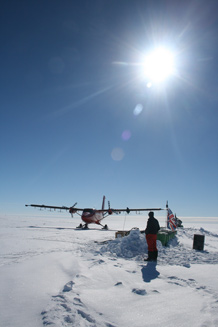Articles

Neil Ross/University of Edinburgh.
Research reveals threats to ice sheet stability in West Antarctica
Threats to the stability of the West Antarctic Ice Sheet have been revealed by new research involving the University of Exeter.
Pulses of warm ocean water that could reach far beneath the Filchner–Ronne Ice Shelf together with a smooth, steep bed beneath the ice sheet may affect the stability of the ice sheet, according to the study.
Published in Nature Geoscience, the research was carried out by a team led by the University of Edinburgh and including University of Exeter geographer Dr Anne Le-Brocq.
A team of Exeter geographers is now analysing the data to predict likely future sea level rise, resulting from ice sheet retreat.
Using radio-echo sound techniques, the team surveyed the thickness of the Institute and Möller ice streams — that feed the Filchner–Ronne Ice Shelf — to determine the underlying landscape. Their measurements reveal a steep reverse slope and a large subglacial basin, around the size of Wales, upstream of where the West Antarctic Ice Sheet meets the Weddell Sea. The bed is fairly smooth, with little in the way of ‘pinning points’ that could delay retreat of the ice sheet.
The smooth, steep surface below the ice sheet and the projected increasing melt rates raise concerns about the Weddell Sea sector of the West Antarctic Ice Sheet.
University of Exeter geographers are now using a state-of-the-art computer-based model of ice flow, to analyse the newly collected geophysical data. Scenarios of increased ocean-driven melting beneath the Filchner-Ronne ice shelf, based on the work of Hartmut Hellmer and colleagues (published in an associated Nature paper), will be investigated to establish the conditions required for ice sheet retreat and the potential sea level rise which may result.
University of Exeter geographer Dr Anne Le Brocq said: “This research has raised new concerns about the vulnerability of The West Antarctic Ice Sheet. We are now focused on using the data to determine the potential rate of ice sheet retreat and what the future impacts of this could be.”
Date: 11 May 2012
